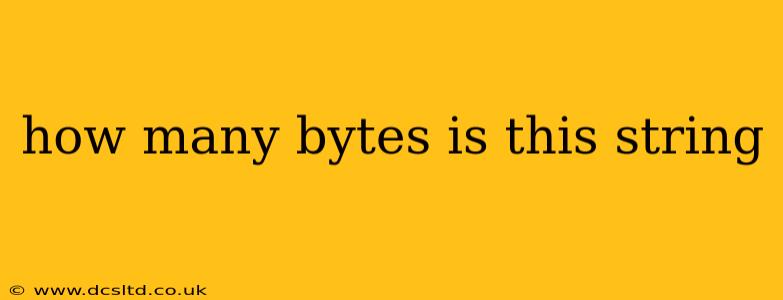How Many Bytes is This String?
Determining the number of bytes a string occupies depends on the character encoding used. There's no single answer without knowing the encoding. Let's explore this crucial aspect of string representation.
What is Character Encoding?
Character encoding is a method of representing characters (letters, numbers, symbols) as numerical values. Different encodings use different numbers of bytes per character. The most common encodings include:
-
ASCII (American Standard Code for Information Interchange): Uses 7 bits (one byte) per character, representing 128 characters. This is limited and doesn't support many international characters.
-
UTF-8 (Unicode Transformation Format - 8-bit): A variable-length encoding. Common ASCII characters use one byte, while others require more (up to four bytes). It's widely used on the web and is capable of representing virtually all characters from all languages.
-
UTF-16 (Unicode Transformation Format - 16-bit): Uses either two or four bytes per character. Most commonly used characters require two bytes.
-
UTF-32 (Unicode Transformation Format - 32-bit): Uses four bytes per character. This is the simplest encoding but consumes the most memory.
How to Calculate the Number of Bytes?
To accurately determine the byte size, you need to know the string and its encoding. Here's how you'd approach it:
-
Identify the Encoding: The encoding is usually specified when the string is created or stored (e.g., in a file or database). If unsure, it's often UTF-8 for web applications.
-
Determine Character Length: Count the number of characters in the string.
-
Calculate Bytes based on Encoding:
- ASCII: Number of characters * 1 byte/character
- UTF-8: This is tricky as it's variable-length. Most programming languages have built-in functions to get the byte size of a UTF-8 string.
- UTF-16: Number of characters * 2 bytes/character (approximately, some characters might use 4 bytes)
- UTF-32: Number of characters * 4 bytes/character
Example: "Hello, World!"
Let's take the string "Hello, World!".
-
In ASCII (if possible): 13 characters * 1 byte/character = 13 bytes. (Note: This only works if the string contains only ASCII characters; the comma and space are ASCII, but this won't work if accented characters, etc. are used.)
-
In UTF-8: This requires a programming language or tool to determine the exact byte size. It will likely be close to 13 bytes.
-
In UTF-16: Approximately 13 characters * 2 bytes/character = 26 bytes.
-
In UTF-32: 13 characters * 4 bytes/character = 52 bytes.
Programming Language Examples
Most programming languages provide functions to calculate the byte size of a string. Here are a few examples (the specific function might vary slightly depending on the language and libraries used):
- Python:
len(string.encode('utf-8'))(for UTF-8 encoding) - Java:
string.getBytes("UTF-8").length(for UTF-8 encoding) - JavaScript: There's no direct way to get the byte size of a string; it's dependent on the encoding used by the underlying system. Libraries like
text-encodingcan be used. - C/C++: Using standard library functions related to the encoding in use, often involving
strlenand potentially additional character handling functions for multi-byte encodings.
Frequently Asked Questions (FAQs)
What is the difference between a character and a byte?
A character is a single unit of text (like a letter, number, or symbol). A byte is a unit of computer data consisting of 8 bits. The number of bytes a character occupies depends on the character encoding.
Why does UTF-8 use a variable number of bytes?
UTF-8 is designed to be efficient. Commonly used ASCII characters use only one byte, conserving space. Less frequently used characters, representing a much wider range of characters across languages, use two, three, or four bytes. This makes UTF-8 both efficient in terms of space and capable of representing virtually any character.
How can I tell what encoding a file is using?
The encoding is often specified in the file itself (e.g., a BOM – Byte Order Mark – might be present), or in the metadata associated with the file. Text editors and programming languages often have tools to detect the encoding.
Understanding character encoding is fundamental for accurately determining the byte size of a string and handling text data correctly in your programs and applications. Always specify the encoding when working with strings to avoid unexpected behavior or errors.
